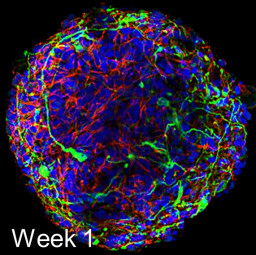Incorporation of stem cell-derived astrocytes into neuronal organoids to allow neuro-glial interactions in toxicological studies
Main Article Content
Abstract
Human cell-based neural organoids are increasingly being used for investigations of neurotoxicity and to study the pathophysiology of neurodegenerative diseases. Here, we present a fast and robust method to generate 3D cultured human dopaminergic neurons (LUHMES) for toxicity testing and long-term culture. Moreover, a plating step was introduced to allow generation of neurite networks with a defined 2D orientation and several mm length while all cell bodies (somata) remained in a 3D, dome-like structure. These cultures, named 2.5D (for 2.5 dimensional), offer new approaches to quantify toxicant effects on organoids by standard technology and in high throughput. For instance, the system reacted to the parkinsonian model toxicants MPP+, rotenone and MG-132, and to the ferroptosis-inducer erastin. Moreover, stable incorporation of human stem cell-derived astrocytes or microglia was possible. Addition of astrocytes stabilized the post mitotic state of the LUHMES neurons and thereby allowed formation of a stable microphysiological system. Neuroprotection against the proteasome inhibitor MG-132 and the ferroptosis-inducer erastin was mediated by such glia, exemplifying the crucial protective role of astrocytes in neurodegeneration. The modularity of the system was further employed to incorporate microglia together with astrocytes into the organoids. Such ratio-defined, three cell type-based organoids will allow new approaches to study human pathophysiology and toxicology of the nervous system.
Article Details

This work is licensed under a Creative Commons Attribution 4.0 International License.
Articles are distributed under the terms of the Creative Commons Attribution 4.0 International license (http://creativecommons.org/licenses/by/4.0/), which permits unrestricted use, distribution and reproduction in any medium, provided the original work is appropriately cited (CC-BY). Copyright on any article in ALTEX is retained by the author(s).


